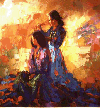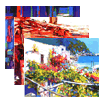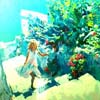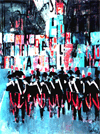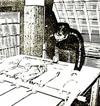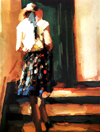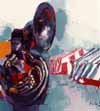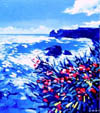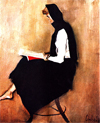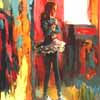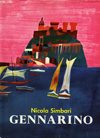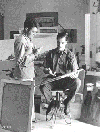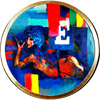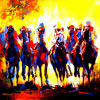Sterling McIlhany
By Sterling McIlhany Art Writer/Journalist and Critic.
As I re-read this outstanding ‘article’ written by Sterling, in ’61, I decided that no one has ‘told’ of SIMBARI with more ‘love’ for Nicola’s “theatrics” and superb talent . . .
How very sad I was to read of his accident and death . . . I wish I could have told him of my love and respect for him . . . a truly wonderful friend . . . Thank you, Sterling
(from “American Artist” Magazine - - April 1961)
“ I must confess that this article could be more honestly titled something like ‘A Hedonist’s Guide to Italian Food and Drink’. Not that Nicola SIMBARI is not Roman or a painter, he is both.
My Interview with this talented young painter has no parallel experience among the several artists I have talked with and written about before. One always expects, and I suppose, unconsciously hopes for, a certain amount of unpredictability in the creative person; certainly Nicola Simbari is no disappointment.
I was well aware of Simbari’s work before I met him. Besides outstanding shows in Rome, London, and Palm Beach, his numerous awards include the Gold Medal for the best Poster of 1954, awarded to him by The Italian State National Concorse, in Rome; award for the best stage set for the play “Tarantella Napolitana”, produced in Rome in 1953; and the honour of painting Murals in the Italian Pavilion , at the Brussels World Fair in 1958. In New York, exhibitions of his work at the Bianchini Galleries, and Young & Rubicam had made me anxious, when I arrived in Rome last summer, to meet the painter whose colourful , imaginative style, already a success in the European art world, was capturing an equally enthusiastic American audience.
Trying to sandwich in the several assignments I had set myself for the four weeks allotted to Rome, I was afraid, at first, that there would be little time left for the visual and culinary pleasures that rank secondly to the Art Treasures of that great city.
Little did I imagine that one of these assignments was to result in the kind of introduction to Roman Life that the average tourist, either through battle fatigue or lack of imagination, rarely encounters!
Everything began inauspiciously enough. Upon enquiring after Simbari at Rome’s Obelisco Gallery, where he was currently showing, I was informed, with an apologetic shrug of the shoulders, that the Simbaris were vacationing in either Spain or Capri, and no one could say exactly when they would be back - - perhaps not until Fall. This gloomy situation was happily reversed that same morning, by a telephone call at the hotel, from the artist’s wife. They had just returned unexpectedly and understood that I wished to see them.
That evening, armed with a ball-point pen and ‘posta-aerea’ notepaper pad, I was ready, when the Simbaris roared up to the Hotel in a pale blue Giulietta Sprint. I was warmly greeted by a striking couple: Nicola, an athletic looking thirty-two and his wife, Elfrida, who is English and an actress (most recently in “The Nun’s Story”, filmed in Rome) .
For the site of our first “Interview” , Simbari decided on one of Rome’s most famous outdoor restaurants, overlooking the city from the ancient Via Cassia. After a hair-raising drive through Rome’s free-wheeling traffic (the first of several Simbari-conducted Tours, that were to reduce this interviewer to an almost Oriental Fatalism) we settled down over a dinner that, to a New Yorker, at least, seemed to rival the wildest excesses of the Borgias. Between bouts of groaning antipasto carts and succulent Roman meat and fish dishes - - punctuated by a variety of local wines - - I managed to come out of the resultant euphoria long enough to discover something of Simbari’s background.
Born in San Lucido (Marina) in Calabria, he came to Rome at the age of three. So, Nicola is really a Roman, or, as he explains, what the Romans call a “Romano di Roma” - - - “My Father worked as a builder for the Vatican.” Simbari added in his fluent Roman-accented English, “I became familiar with the Vatican Art from the age of five on. When I was seven, I learned to love the Sistine frescoes. Studying them and the vast art treasures of the Vatican was more fun to me than playing with other children.”
After this rather impressive early background, Simbari went on to attend Rome’s Academia delle Belle Arti, where he enrolled in the complete Art Course - - then, as now, a very classical back-grounding in the Arts.
“Sometimes” Simbari continued, “we devoted five or six months to learning and drawing from one classical sculpture. The entire first year was spent finding geometric values in single elements, such as a hand or a foot. I spent my summer vacations away from school, drawing every day, in Rome’s churches - - always figures.” “I am Mediterranean,”, he added emphatically, “there is always the human being.”
Such a disciplined Art Background, which is almost an anomaly, in ‘today’s’ insistence on “creative growth” by experimentation, has given Nicola Simbari a firm technical mastery of his media. And this is important. But, add to this, a richly developed imagination, which is a product of an exuberant, inquiring attitude toward Life, and, the result is a vividly realized world of colour and light: sometimes highly stylized as in his illustrations for children’s books or his paintings of Roman policemen on horse-back , or evoking a string sense of visual reality as in many of his marine paintings.
Racing toward the beach at Ostia, the following afternoon, Simbari delightedly called our attention to everything that caught his eye - - colourfully costumed Carabinieri, a particular Church door or cupola, the mellowing effects of the Roman sun falling on ancient cornices and pediments, patterns of ‘umbrella’ pines, outlined against a deep blue sky, a row of crazily painted shacks at a construction site - - This excitement for everything visual - - the discovery of light and pattern in what to most people are simply objects of indifference - - is a key to the richness of design and textural effects that characterize Simbari’s more decorative paintings. Vivid squares of colour laced together with calligraphic line emerge suddenly as a fantastic cityscape, calling to mind the small villages of central Italy; gaily costumed, banner carrying processions, march across a broad swathe of green, toward a distant town. Within the frame of whimsical fantasy there is a knowing feeling for the particular time.
Several of his earlier paintings were inspired by this simple, colourful life, where Simbari becomes most closely involved with visual illusion and expresses his firm technical background. Emphasizing the basic geometry of design and composition, Simbari creates with bold use of the palette knife a solid world in which human being and nature are taken into equal account. This is a Mediterranean World of brilliant light that at once reveals and obliterates colour by its very intensity and in which the single human bears a classical relationship. Nothing is forced and no point is made. One hardly knows which is more compelling here, the sensuous paint surface with its richly applied texture or the aloof treatment of the subject matter, in which the human being gains its identity by its very generality, by not being tied to immediate reaction. If environment alone were the determinant of creative output, then the Simbaris’ home would account for a lot. In an ancient building nestled at the foot of the Janiculum (Gianicolo) Hill, sunny rooms open onto a large terrace overlooking a thickly wooded garden. Inside, the walls are covered with a collection of drawings and paintings, many of them Simbari’s own. Propped up on a large easel was a canvas in progress, again a Fiumicino theme: huge boulders and fishermen.
In this pleasant and quiet environment (a rarity in one of the world’s noisiest cities!), we looked at Simbari’s work, while he discussed his approach. “When I am painting I am like a writer. I must have something to say. My paintings are like entries in a diary; they are my reactions to all the things I’ve seen. I can’t absorb quickly, it takes a great deal of time. When I return to New York I may paint it . . . I’ve done very little about it up to now !”
It is no wonder that certain visual effects are referred to by Romans as Simbaresco. When most artists have become internalized and evasive in their reference to what takes place around us - - to the extent that pictorial values are achieved only by escape from the pain of visual involvement - - Simbari, in the tradition of Carpaccio or Canaletto, unabashedly revels in the pleasures of the isolated scene. And his stage is nearly always the Italian world. If this seems to be a limiting factor in an age preoccupied with universalities, it is also a reminder that human experience often derives from the personal view and the particular moment.
In the shadow of the Olympic Pool, at Ostia, Simbari explained his interest in the visual world and the human figure. “I have an animal reaction to the world”, he declared. “Everything is physical and human. Even the marble lion, of Bernini’s Fountain of the Four Rivers (in Piazza Navona), is human, because he is thirsty.” - - - a very Baroque attitude! “I have rejected the purely abstract”, Simbari continued, “ I’ve done it, but now I use it just to refresh after a hard day’s work of painting. Abstract Expressionism is like hearing noises of a crowd outside your window without seeing their faces - - a blurred vision of Life. There is a loss of individuality. Abstract Expressionism has become a modern day version of the nineteenth century Salon, a great fashionable crowd of dilettantes. I hate mass movements of any kind.”
From the beach, we roared off again - - at breakneck speed - - past the lonely ruin of Ostia Antica, Rome’s ancient port, to the small fishing village of Fiumicino, a spot almost unknown to the tourists and not much frequented by the Romans. This sunny town with its stone breakwaters, fishing nets, and small craft, is a special love of Simbari’s.
Discussing his approach to Oil, Simbari had this to say, “I must know the subject very well - - let it grow on me. I no longer make any preliminary sketches, although I sometimes take documentary photos of a scene. There is no limit for a painting; even newspaper photos can be stimulating.” Simbari continued, “ Ordinarily I use canvas. I begin with a blue and ochre under-painting, then build up from there. I always use a palette knife - - - very seldom brushes, except for final definition, when I want a more realistic look. In terms of technique, I want people to understand, visually, what I have done. A rock must look like a rock. As for the time I spend on a single painting, this varies. Sometimes it takes as much as three months, because of my tendency to do a lot of work early and then return much later, when it is dry. I like tempera very much, “ Simbari continued, “ It’s like writing: very fast and easy with a wide range of effects. I work on Fabriano (and other good Italian papers) paper, which I wet thoroughly under a pump on the terrace. For Tempera, I use brushes, beginning with a preliminary wash. Then I build up from large areas to final details, working rapidly. By the time I have finished, the paper is completely dry. The maximum time I spend on a tempera painting is three to four hours.”
Throughout, his typically Roman boldness and simplicity are evident. Nicola Simbari’s generous acceptance of Life on all levels - - from the sensuous joys of classical cooking and good wines to the human-oriented landscape that inspires his art, is an affirmation of the values and pleasures available to all imaginations free enough to find them.
Sterling was to become a great friend of ours . . . and his words, in this article, are amazing - - so real, I almost feel I am there again . . .
Back to the top



